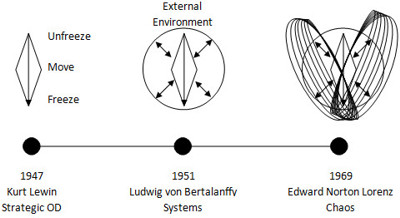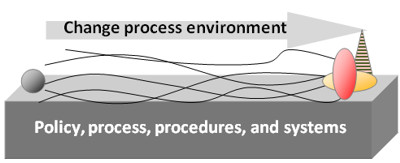The reality of chaos theory – will you ignore, control or embrace?
They say 70% of strategic initiatives fail, and of those that succeed are only 60% effective. In an environment of uncertaintly, chaos theory presents a likely explanation. My question to you is: will you 1) pretend it does not exist; 2) attempt to conform it to your will; or 3) accept and embrace it with open arms?

Three approaches to change: strategic, systems and chaos

Change is a constant. Ten years ago I pondered what to do with my life, without considering concepts we deal with now such as a global financial crisis, climate change, worship of the reality TV celebrity, the rise of social media, and the progression of technology towards a more mobile market. Within this changing environment, we are meant to plot career paths and organisations are supposed to plan strategic roadmaps. I wonder if we are meant to be clairvoyant, genius, or simply insane!
The approach to the change dilemma that seems the easiest to grasp is a strategic approach to change. One of the first contemporary approaches was Kurt Lewin’s unfreeze, move, freeze model, released in 1947. This approach seems very attractive to the uninitiated manager, as they declare “I will just shake things up, move things around a bit, and make mandates after the fact. It (and I) will be great and successful!”
The challenge with this approach is that it can assume a “best way”; that we know everything about the situation before starting our inevitable path towards change. The systems approach attempts to address this discrepancy. Around 1951, biologist Ludwig von Bertalanffy used the environment as a metaphor to identify the myriad of interactions individuals and organisations have with their environment. Finally, we had a framework to holistically map all of the inputs and outputs for our particular situation.
Except there are a lot of inputs and outputs, and an infinite combination of variations to those inputs and outputs. So many that anyone less than Super-Manager throws their hands in the air at situation that could only be identified as chaos. As such, chaos theory gained ground in the 1960s with Edward Norton Lorenz and his analogies to weather patterns, coining the term “the butterfly effect” to describe how seemingly insignificant influences can have unforseen changes of a disproportionate magnitude.
Supporting Chaos with process and controls

The truth behind chaos theory’s premise can be found in topical headlines such as “Ten brands that may disappear in 2011” or “Companies affected by the Deepwater Oil Spill”. Ask any of the organisations mentioned in these articles if they felt approaches such as a planned strategic approach or a holistic system approach prepared them for what they are facing. I suspect they will say “No”.
Chaos theory is not an easy out for managers to justify a lack of planning or controls in their organisations, however. On the contrary, acceptance of uncertainty mandates a solid foundation of normalcy to support an environment of constant change. This foundation is in the form of policies, processes, procedures and systems, in that order. Volumes could be written on practical frameworks that are available for implementing the solid foundation (ISO 9000 and the Project management Body of Knowledge being two I rely on).
For now, I am focusing on a shift in our perspectives.
Choose your response to chaos
As I recently mentioned in my birthday post, being a production manager in a leading digital studio has many challenges. In addition to the expected changes of new clients and projects, the studio faces impacts such as global financial fluctuations, dynamic technology directions, and changing employment cultures. Over the past three years, I have felt my perspective shift through the three phases of strategic change, systems approach, and chaos acceptance that took academic change management literature three decades to acknowledge.
I will share three options I have identified from that process, choices we all have in the reality of today’s commercial mandate:
- Avoid and deny
Pretend the approach of strategically planning out change is sufficient. If you are really good, you can keep up the facade long after your company goes under or you are transitioned out of your role. - Control and contain
Try to contain the chaos. Large companies trying to control communication channels in today’s social-media rich environment is a good analogy. So are managers who burn out from trying to control the uncontrollable (Chad raises his hand here). - Support and embrace
Change steals your most valuable resource, your time. If you spend all your time in operational activities, you will be simply taken along for the ride. Invest in the foundational processes to make the daily grind as efficient and flexible as possible. When unplanned change does happen, you will be free to embrace and take advantage of the change.
